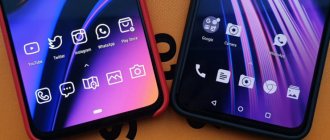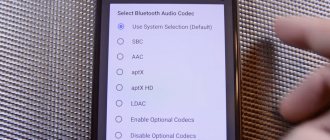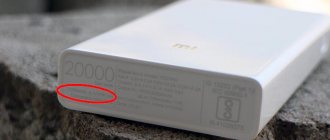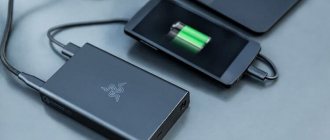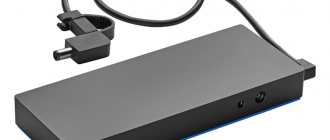Hello friends! Today's topic is relevant for people who are constantly on the move. It doesn't matter if you are a tourist, an athlete or a student. Anyone can find themselves in a situation where, at the most unfortunate moment, they are left without communication. How to prevent this? Today we will talk about how to choose a power bank for your phone and always be within reach. Modern gadgets not only provide a lot of opportunities, but also cause a lot of inconvenience by quickly draining the battery. You will learn what points to pay attention to when choosing this device and what to give preference to.
After reading this article, you can easily choose a reliable assistant. It will give you additional hours of mobile communication and Internet.
What is a Power Bank?
The device is called differently - external battery, portable or mobile charger, portable charger. In this case, we are talking about the same thing - about charging for a phone without an outlet.
The advantage of a Power Bank is that it can be used to charge electronic gadgets when other methods are not available. This can happen not only in situations where there are no outlets nearby or they are all occupied, but also during long trips, travel and even hiking trips. For those who like to often get out into nature, there are special external batteries equipped with a solar battery.
A power bank is a battery that needs to be pre-charged and then used to power other devices.
The portable charger is small in size and lightweight, making it easy to carry in your bag. Gadgets are connected to the Power Bank via a cable connected to the USB connector, which makes the external battery a universal device. It can be used not only to charge your phone battery, but also for tablets, cameras, laptops, and players.
Some models of portable devices have more than one USB connector, which allows you to charge several gadgets at the same time.
Phones with power transfer function
Some mobile devices can transfer battery power to other gadgets. Example models: • Texet TM-D328 and TM-D327, • Senseit L208 and P7, • Fly FF244, • Explay power bank, • Philips X130 and X1560, • Land rover X10 flip, • Oukitel K10000, • as well as some top smartphones from Chinese brands.
Their common drawback is low current. Often they are inferior in characteristics to full-fledged power banks. Such phones offer the ability to charge other user gadgets (the same fitness bracelet or smart watch) without an outlet as a useful but optional feature.
If you have any questions, you can send a message on VKontakte vk.com/neovoltru to get help. Subscribe in the group to news from the world of gadgets, learn about improving their autonomy and progress in scientific research on batteries.
Calculating the number of charging cycles
PowerBank can be used to recharge electronic devices as many times as its capacity exceeds the battery capacity of the devices being charged. When choosing a portable battery, it is recommended to focus on several charging cycles. To do this, you need to multiply the battery capacity of the gadget that you plan to connect to a portable charger by 2-2.5.
For example, if you are looking for a portable charger for mobile phones with a battery capacity of 2600 mAh, you should not buy a power bank with less than 5200 mAh.
Please note that PowerBank will not charge gadgets whose battery capacity is greater than the capacity of the external battery.
It is worth understanding that a portable battery will not be able to fully charge the device if the capacity of their batteries is the same, since the PowerBank is consumed to keep it running.
Wireless car
This charger is a holder that securely holds the smartphone and prevents it from falling while the car is moving. This memory makes it possible to use a smartphone as a navigator.
- sticker – provides reliable fixation of the charger, but is designed for one-time use;
- a clothespin holder in the air duct is a reliable and simple method of fastening, it can be used multiple times, this option is most common;
- suction cup holder for windshield, dashboard - can be used an unlimited number of times, but is not suitable for attaching the charger to a textured surface.
- mechanical (manual) clamp - a cheap and simple option, ensures compatibility with many device models;
- gravity clamp - compares favorably with the previous method with greater reliability and ease of operation;
- magnet is a reliable option, compatible with models of different sizes, but not suitable for devices that are too heavy;
- sensor clip – reacts to the approach of a person’s hand or portable device. The most convenient way to mount your smartphone. Cons: high price, dependence on nutrition.
Expert opinion
It-Technology, Electrical power and electronics specialist
Ask questions to the “Specialist for modernization of energy generation systems”
How to charge a phone without a charger - old, Samsung, iPhone and others, what to do if there is no socket and frog, on the street • Electrical world Structurally and according to the principle of operation, chargers are divided into two types: adapters themselves, they are also power supplies; and external chargers, better known as power banks. Ask, I'm in touch!
Charge currents
The current strength affects the charging speed of devices. USB ports of 1 A or 2 A are common in external batteries. A 1 A connector is needed for charging phones, smartphones, players, and e-books. A 2 A USB port is suitable for large equipment - tablets, cameras, laptops.
There are PowerBank models with multiple connectors. Most of these chargers have ports with different current strengths.
Mobile batteries are equipped with controllers that limit the supply of voltage to devices with a weak battery, so the player or phone will not be damaged if it is connected to a 2 A connector. Otherwise, when connecting large equipment to a connector with a weak current, the charging process will occur slowly.
Breathing mask AIR
The small mask incorporates the operating principle of a wind turbine. The generator rotates as you inhale and exhale. To charge your phone, you just need to put on a mask and lie down to rest or exercise.
During active activities, the phone can be recharged by 10-15 percent in 40 minutes. This charging device is economical, and when using it at night, you can completely abandon standard charging from a wall outlet.
How to choose?
To choose a good external battery, you need to start from the needs of the buyer. You should understand which gadgets you plan to charge, in what quantity and how often.
There is no point in overpaying for a PowerBank with a large capacity if you choose an external battery for your phone that can be charged at fairly minimal rates. To charge a laptop, you will need a device with at least 20,000 mAh; less capacious ones simply will not work. Please note that the larger the capacity, the greater the weight, and some models may not be comfortable to carry on a daily basis.
When using tablets and photographic equipment, it is better to opt for models with higher current, which will ensure fast charging.
If you need to charge the battery of your phone or other gadgets that do not have a USB port, choose a model that includes adapters for connecting older devices.
Portable chargers can be made of plastic or metal. In the second case, the phone charger will be stronger and less susceptible to scratches, but its price and weight will be higher.
You can find PowerBanks with unusual designs. They can be made in the form of various toys, animals or have any other shape. It is worth keeping in mind that such decorative devices, due to their original appearance, have a higher cost, although they may not have high performance.
Advantages and disadvantages of an external battery
Despite the fact that power banks are indeed indispensable devices in the life of a modern person, they have not only advantages, but also disadvantages.
Advantages and disadvantages
Relatively small dimensions, allowing you to take an external battery with you for a walk
Can charge any device with USB output
Large selection of similar devices in the store
Public availability (power banks are sold absolutely everywhere)
Limited volume and gradual drawdown of capacity
If the device is of poor quality, there is a high risk of housing swelling and even a small explosion
Of course, the disadvantages of external batteries cannot under any circumstances outweigh their advantages. It is only important for a person to choose the most suitable device that will meet all the requirements.
Thus, at the end the buyer will receive a device with a sufficient amount of energy. And if the device is branded, then its use will not pose any danger.
However, gradual drawdown of capacity is a problem that accompanies the period of operation of any power bank. It doesn’t matter whether the battery purchased is expensive or cheap. Over time, it will still lose 10-30% of its specific capacity. But, thanks to the relatively low cost and ubiquity, replacing a portable charger is not difficult.
Crazy and even dangerous “ideas” from the Internet - don’t do that!
And finally, some know-how on maintaining and charging smartphone batteries found on the Internet. Let’s try to figure out how effective they are and, most importantly, how safe they are.
We pierce
The issue, according to many Bolgers, can be resolved in an elementary way. Carefully pierce the battery case, compress it with pliers (alternatively, press it with a brick, compress it with a clamp, etc.) so that the battery takes on a normal geometric shape, and seal the hole.
How effective is this “treatment”? Absolutely ineffective. We eliminate the effect, not the cause. It’s not just that the battery is swollen - there’s clearly something wrong with it. It is better to get rid of such a power source.
Regarding safety. By piercing the battery case, we risk (and this risk is very high) causing an internal short circuit and turning the battery into a thermite bomb that will burn even under water. And if the battery not only catches fire, but explodes, then we will definitely be left without eyes.
Expert opinion
Alexey Bartosh
Specialist in repair and maintenance of electrical equipment and industrial electronics.
Ask a Question
Curious. Some pro-piercing bloggers recommend (quote): “Before piercing, find a non-flammable material that can cover the flame. This way you will block the access of oxygen and eliminate the combustion process.” And laughter and sin...
We arrange a short circuit
This method, according to some, allows you to restore battery capacity if it has decreased due to age. Sometimes it is supposedly possible to increase the capacity by 20 (!) percent. So, remove the controller from the battery and short-circuit the battery contacts for 3-4 seconds. Ready. Let's collect and rejoice.
How effective is this treatment? It is not only ineffective, but, on the contrary, will cause the opposite effect. We will lose everything we had. This method is only suitable if we need to make a thermite bomb quickly and with minimal effort. A current shock during a short circuit will cause an internal short circuit of the battery with all the ensuing consequences - see the animation above.
Even if the battery does not explode immediately, there is a high probability that it will happen in an hour/week/month. And God forbid that only the smartphone is damaged.
Put it in the refrigerator
This method of restoring capacity (still by the same 20%) involves placing the battery in the freezer for 6 hours (as an option - for 2 hours, a day, etc.). One of the bloggers suggesting this writes (quote): “As mentioned above, cold is tolerated much better by the battery than high temperatures, so a number of experts recommend preventive maintenance of the device using cold.”
Dear fabulist, “bears it much better” and “rejoices very much” - is there a difference? By freezing the battery to a decent minus, we will simply kill it or, at best, shorten its service life. There can be no talk of any increase in capacity. Where will it come from? Will Santa Claus give you a ride on reindeer?
We double the resource
It would seem, how? Elementary Watson. We discharge the battery not to zero, but to 50%, and the number of charge/discharge cycles doubles.
I’ll say more on my own behalf. If you discharge the battery not to zero, but to 99%, then the number of charge/discharge cycles will increase 100 times. And this is true, since the cycle is called full discharge/full charge. By discharging the battery to half and charging it to 100%, you complete half the cycle. So don’t engage in tyranny, it’s both stupid and inconvenient.
#1. Myth about energy costs
It is a mistake to say that charging online without a connected phone consumes no electricity at all. All power supplies (it’s more correct to call a charger that way) of our gadgets are pulsed. This means that if there is no load on the power source, this charger still consumes electricity due to the features of its circuit. In other words: a charger that is plugged into the network and does not charge the smartphone, nevertheless consumes electricity.
It must be said right away that energy consumption in this case is minimal. In this regard, you can never unplug the charger from the socket at all, since you will not be able to save on your electricity bill in this way. Yes, it does, but so little that even the most greedy person cannot say that he saved on it. Therefore, the conclusion is simple: even if you plug all your chargers into sockets at the same time and leave them there forever, this will not affect your financial condition in any way.
As an example, let's calculate how much my Lenovo phone charger consumes. All technical characteristics are indicated on the case.
The current consumption on the high side is 0.3 A, voltage 220 - 240 Volts. On the low side, the voltage and current are respectively 5 Volts and 1.5 A. From here it is easy to calculate the power in CHARGE MODE: 5 V * 1.5 A = 7.5 W. That is, while charging, my phone consumes 7.5 W per hour. This will be 180 W per day. Per year – 65.7 kW. Actually a significant figure, but there is one thing. Your meter will accumulate such consumption if the phone is CHARGED ALL YEAR ROUND without interruption.
And since, after removing the cord from the phone, the consumption of the charging itself at idle is a fraction of a percent of this figure, the family budget will not suffer much from this, so there is no need to worry about excessive power consumption when charging is left on.
The issue of electricity consumption by chargers operating idle even interested a group of researchers who set out to find evidence of why it is impossible to leave the charger in the outlet. After unsuccessful attempts to distinguish the meter readings with and without plugged-in charges, specialists had to connect seven charges to the network, only then did a small difference from zero appear.
Based on the calculations, it was concluded that seven chargers, constantly connected to the network, will generate about two kilowatts per year. This is very little, which is why we say that charging on without a charging device will not affect your well-being in any way.
Duration of work
The MTBF of modern chargers ranges from 50 to 100 thousand hours. This is approximately from 5 to 11 years.
Although, of course, in reality, the resource is always limited by the lifespan of electrolytes. And it is much lower than 50 thousand.
But even with a minimum period of 5 years, the charger must periodically also do its direct job - charge the phone.
Now remember the last time you changed your smartphone. This period was clearly less than or equal to 5 years. It turns out that you would rather buy yourself a new communication device than the power source from it become unusable.
And we’re not even talking about the constant manipulation of turning the device on and off from the outlet, which causes harmful transients.
They are the most common cause of failure of electronic gadgets. Most accidents occur precisely at the moment of switching.
And because of these frequent switchings, the power cord near the case is constantly bent. As a result, although the device circuit itself remains working, the charger is thrown out due to the breakage of thin wires in the wire.
You can also remember about broken terminals in the socket and possible sparking. This is where there really is a real chance of fire.
Anti-sparking devices are just coming into our homes, and many people still don’t even know about their existence and purpose.
To summarize, we can say that you can leave what is called a high-quality charger in the sockets at all times. Nothing will happen to him.
But if you are a suspicious, cautious person for whom safety always comes first and you are inadvertently familiar with Murphy’s laws, even unplug the TV and refrigerator.
And to recharge your smartphone, find a prominent place where there will be no problems with frequent disconnections from the power source.
https://youtube.com/watch?v=I61neL9CnvI
USB Type-C
The standard designed to replace the aging microUSB is USB Type-C. The maximum theoretical data transfer rate through this connector is up to 10 Gbit/s, which is provided by a contact group with 24 pins. However, it all depends on the implementation in a specific device model - if the manufacturer did not provide support for USB 3.0 or 3.1, limiting itself to USB 2.0, then there will be no increase in speed compared to MicroUSB. By the way, the dimensions of the connector are 8.34×2.56 mm. A little more than MicroUSB, but this is a small price to pay for the multiple performance gains: USB Type-C remains very compact and can be used in almost any device.
An additional advantage of the updated interface is the symmetry of the oval connector. Now users will not have to turn the plug over several times, swearing at engineers who are not familiar with the concept of “usability”. The charging speed has also increased noticeably, and the maximum theoretical power supported by the interface (with USB 3.1) reaches 100 W, but this option requires advanced implementation - standard profiles are limited to 7.5-15 watts. The declared mechanical resource is no different from MicroUSB and is about 10,000 connections.
Safety
Modern chargers are not just a miniature transformer that reduces the voltage from 220V to 5V.
They have long been smart devices that initially have built-in protection against voltage surges.
Pay attention to the housing of your power supply. You will be surprised, but it is capable of operating in very wide ranges from the 220V standard
In high-quality blocks, the circuit is protected against overheating and short circuits. Such devices themselves are very difficult to burn.
Also, do not forget that today in almost every second apartment it is considered the norm to have a modular voltage relay in the panel board.
Of course, power surges happen here, but in 90% of cases they occur in private homes powered by old power lines.
Moreover, they are made with bare wires, and not with insulated SIP wire.
In urban high-rise buildings, such problems are observed much less frequently. The most likely reason that can burn your charger is a lightning strike on a 10 kV or 0.4 kV power line.
In this case, a short-term pulse of more than 1000 volts passes through the entire 220V electrical network. Even a voltage relay will not save you from it.
The only thing that helps here is the use of other modern devices - SPDs. But for some reason they are much less common among us than the same RCD or UZM.
Now just walk around your apartment and see what you have on 24 hours a day, in addition to charging. This will probably turn out to be:
TV
refrigerator in the kitchen
boiler
microwave
washing machine
But even despite the above-mentioned danger of an overvoltage impulse, you do not pull the plugs of these devices several times a day from the socket blocks.
Then the question is why this needs to be done with cheap charging, which costs tens of times less than everything else.
Moreover, there are also modern wireless chargers.
Here you can order one of the most popular models at an affordable price and with good reviews with free delivery.
Their intended purpose is to be constantly plugged in for your convenience. You throw your phone on this “pancake” at any time, and it charges without any problems.
Nowadays they even produce lockers with wireless chargers built-in.
There are also sockets where there is a USB connector in parallel with 220V.
You can buy similar copies here.
They certainly never turn off and are always energized.
Inside such devices you will not find high-quality components, much less any smart protection.
These are the types of chargers that 100% need to be pulled out of the sockets. Moreover, it is better to avoid using them altogether. Even at normal voltage, they can burn your phone.
The main danger in them comes from capacitors. If one of them is close to the transformer, it heats up.
This heating subsequently leads to swelling and explosion. The Chinese also save on the copper wire of the transformer itself. As a result, such charges heat up, hum and vibrate.
When vibrating, the turns begin to rub against each other and the layer of insulating varnish is erased. An interturn short circuit occurs.
As a result, the output of the charger is no longer 5V, but 9-12-110, etc. The same capacitors are usually designed for a voltage of 16V and, when overvolted, they jerk so much that the case shatters into small pieces.
To identify a faulty low-quality product, simply plug the charger into the outlet at idle without the phone. After a few minutes, go up to it and touch the body.
If it gets hot, your charger is most likely faulty. Be sure to turn off such a device; it should not heat up.
Also, it should not beep at idle. This is also an indirect sign of an imminent breakdown.
And to 100% avoid problems during a severe thunderstorm with lightning, turn off not only the power supply of smartphones, but also all other expensive equipment.
Even if your house has lightning protection and lightning rods.
Lightning is still considered an incompletely studied phenomenon. And not a single expert can tell you how to be sure to escape from their side effects.
Lightning
Previously, the Cupertino company's mobile gadgets used Apple's proprietary 30pin standard, but since 2012 it was replaced by the eight-pin Apple Lightning connector, which is similar in charging and data transfer speeds to MicroUSB. Calls from officials and the media did not lead to the abandonment of its own connector; instead, the company released a number of adapters with which you can charge your iPhone using regular USB chargers.
